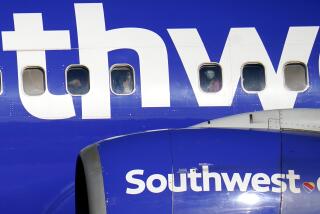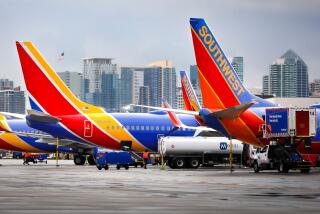Good Year for the Airlines, But Less So for Passengers
Last year, as you may have heard, was a good year for this countryâs passenger airlines. Industry figures show that they filled 69.8% of their seats, up from 67.3% in the very profitable year before. They boosted the number of miles flown by paying passengers by 6.7% (to 548.9 billion). And they made billions in profits. (As I write, specific figures are still being sorted out.)
But by several other measures, 1996 was a bad year indeed for those same airlines, and some would say worse for the consumers they carried. A recent release of statistics from the U.S. Transportation Department shows that tardy arrivals and cancellations increased from the year before. Also, crews mishandled more pieces of baggage. More passengers were involuntarily bumped from flights. And, not so surprisingly in light of all that, passenger complaints to federal officials leaped by nearly 18%.
In other words, by every measure federal officials use to assess airline passenger service, 1996 was a letdown. Or, to express the equation in yet another way: quantity up, quality down.
Here are some figures and rankings, all based on domestic flights by the 10 largest U.S. carriers.
On-time arrivals: An on-time flight, by industry definition, is one that arrives within 15 minutes of its scheduled time. These numbers include weather-related delays and since January 1995 also have included delays attributed to mechanical reasons. The 10 largest U.S. carriers together were on time with 74.5% of flights in 1996, down from 78.6% the previous year. Southwest Airlines posted an on-time mark of 81.8%, followed by Continental and Northwest, both at 76.5%. The most habitually late major carrier: Trans World Airlines (TWA), with a 68.5% on-time rate.
Mishandled baggage: Drawn from reports filed by passengers when their luggage fails to turn up on the right airport carousel at the right time, these figures show that your odds of having a bag mishandled by a major U.S. carrier last year were 5.30 in 1,000. (In 1995 the number was 5.18.) The top carriers were Southwest (3.96 reports filed per 1,000 passengers), Continental (4.05 per 1,000) and America West (4.38). The bottom performer among the major carriers: Alaska Airlines, with seven per 1,000.
Overbooking: When airlines sell more tickets than they have seats, they even the numbers out by âbumpingâ passengers, sometimes on a volunteer basis, sometimes involuntarily. In the government tally of involuntary bumps over the first nine months of 1996 (numbers are not yet in on the last three months), the most unreliable major carrier was Southwest. In nine months, Southwest crews bumped 9,455 passengers, or 2.30 for every 10,000 to board. That rate was more than twice the 1996 average of 1.06 bumps per 10,000, and far exceeded leading performers Continental (0.18 per 10,000) and Northwest and American (both 0.54 per 10,000). The majorsâ 1995 rate of involuntary bumps was 1.03 per 10,000.
Complaints: The most common causes of passenger complaints overall were flight delays, cancellations and missed connections, followed by baggage troubles and customer service issues. Altogether, major carriers got 7,105 service complaints last year (or 0.74 per 100,000 passengers), up from 1995âs total of 6,025. Southwest prompted the fewest complaints, a remarkably low 117 among 56.5 million passengers for a rate of 0.21 complaints per 10,000 passengers. Runners-up were Alaska (0.51 per 10,000) and Continental (0.58 per 10,000). The most common target of complaints: TWA, at 1.25 per 100,000.
To make a specific complaint about airline service, consumers can write the Aviation Consumer Protection Division, U.S. Department of Transportation, C-75, 400 7th St. SW, Room 4107, Washington, DC 20590.
Mortality: The numbers above may trouble some travelers. But they pale in comparison to a far grimmer set of figures. In its February issue, Business Traveler magazine reported that 1996 was the worst year ever for commercial air passenger fatalities worldwide, with 1,187 deaths. Among U.S.-based carriers, 342 passenger fatalities were counted, most of them in the Valujet crash in Florida in May and the TWA crash off Long Island in July. That U.S. fatality figure was the worst since 1985, when 486 passengers died in five separate accidents among U.S.-based carriers. Putting the death figures into perspective, the magazine noted that over the last five years, North American airlines averaged 0.2 fatalities per million flights. By another calculation, a passengerâs chances of death on a commercial flight were one in 1.8 million.
Reynolds travels anonymously at the newspaperâs expense, accepting no special discounts or subsidized trips. He welcomes comments and suggestions, but cannot respond individually to letters and calls. Write Travel Insider, Los Angeles Times, Times Mirror Square, Los Angeles 90053 or e-mail [email protected].
More to Read
Sign up for The Wild
Weâll help you find the best places to hike, bike and run, as well as the perfect silent spots for meditation and yoga.
You may occasionally receive promotional content from the Los Angeles Times.







